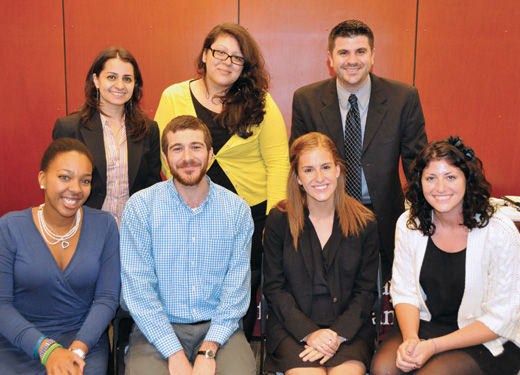It’s a warm autumn day in the Bronx, and the dining room at Part of the Solution (POTS), an emergency food and social service provider, is full. Since 10 a.m. scores of people have been lined up on Webster Avenue, just across the street from Fordham’s Rose Hill campus, waiting for the dining room to open. The lunchtime crowd includes homeless men, young women with small children, and working Bronxites who can’t afford groceries. Families and individuals sit at seven tables covered in red-and-white checkered tablecloths, as volunteers serve food from the restaurant-style kitchen to each guest.
Patrick Janeczko and Danielle Rutsky are in the dining room for the first time. The two Fordham undergraduates learned about POTS in late September at a volunteer fair on campus sponsored by Fordham’s Dorothy Day Center for Service and Justice.
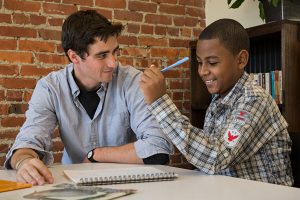
“You see a lot more regular, working people here than you would expect,” Janeczko says, as he gathers silverware. Rutsky is struck by the contrast between the comfortable lives of many Fordham students and the poverty of POTS’s guests. “This is so close to Fordham,” she says. “It’s very enlightening.”
In a neighborhood where the median income is $26,000 a year and the unemployment rate is 12 percent, POTS operates seven days a week, offering people in crisis a place to find succor and start moving toward stability. Last year, the organization served 160,000 meals, making it the largest emergency food service provider in the Bronx.
But POTS is far more than a soup kitchen. Guests get help with immediate and long-term needs. There is the daily meal and a food pantry, a barbershop, and a no-fee doctor’s office. Homeless people can get their mail, take a hot shower, and clean their clothes. POTS social workers help clients navigate the rocky shoals of welfare bureaucracy, signing families up for food stamps and helping veterans and disabled people enroll in federal benefits programs. People who have received an eviction notice or live in substandard housing, whose public benefits have been suspended, or who have immigration problems can get free advice in the legal clinic. The organization helps 20,000 people a year, 6,000 of them children.
“Poverty is a complex problem,” says Christopher Bean, POTS’s executive director. “To be able to work with individuals in all these angles allows us to have an impact.”
Since opening in 1982, POTS has maintained a close relationship with Fordham. On any given day, Fordham graduates and students can be found throughout the airy, bright three-story building. Several alumni are on staff, and one, Francis Conroy, GSB ’79, serves on the organization’s board of directors. Student interns learn social work and nonprofit management skills there. Professors send classes to study and work at POTS as part of their service-learning courses. And a steady stream of volunteers serves in the dining room.It’s a relationship Jack Marth, FCRH ’86, director of programs, says is deeply valuable to the organization. “We would not be able to exist without a lot of volunteers,” he says. “Having a neighbor like Fordham, with students ready, willing, and able to volunteer, allows us to operate.”
Marth was a Fordham freshman in 1982, when POTS was just a tiny storefront soup kitchen. He volunteered to help, working closely with Ned Murphy, S.J., GSAS ’66, one of the organization’s three co-founders. Marth says that experience grounded his education. He was studying Catholic social teaching in the classroom at Fordham and practicing solidarity at POTS.
“Being at POTS was an opportunity to sit down and get to know the people better,” he says, “not just hand them a plate, but to get to know the reality of the people we serve. Father Ned used to say, ‘There is no us and them, it’s we. We’re somehow in this together.’ That’s a message POTS still wants to impart to the students who serve here.”
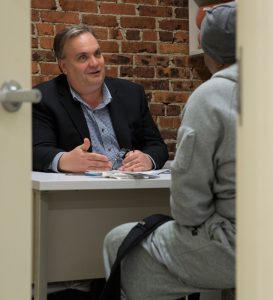
Marth joined the staff of POTS a few years after graduating from Fordham. He worked in the dining room and helped with renovations, then left to work at another nonprofit and earn a law degree. He returned to POTS in 2000 to start the legal clinic.
Today that clinic is led by Scott Wagner, a 2010 Fordham Law graduate. “My job is to try to create an environment that’s conducive to the clients getting services in an atmosphere that is dignified and warm,” he says. “Hopefully our response is one where we prioritize each human being as an individual.”
That compassionate approach to serving people in need appeals to Harrison Pidgeon, a Fordham senior who has been volunteering at POTS since his freshman year.
“I came here with Urban Plunge,” he says, referring to Fordham’s pre-orientation volunteer service program. “I knew I wanted to be part of this. Ultimately, I can never have the perspective of someone going through financial difficulty, but I can be here and eat a meal with them.”
Tucked behind the first-floor dining room at POTS is a pantry that provides groceries to 5,700 families a year. Using a voucher that accords credits based on family size, guests shop among shelves filled with pasta, dry beans, oatmeal, and brown rice, and refrigerators stocked with fresh eggs and produce.
For the past year, Pidgeon has been coming to POTS for Family Club. The 12-week program invites a total of 24 families to meet once a week, on Sundays or Wednesdays. Kids get help with their homework, while adults are paired with case managers who help them set goals and untangle impediments to economic and emotional progress. The centerpiece is a cooking class. Adults learn to make a delicious, nutritious meal, and go home with the ingredients to replicate it on their own. At the end of the evening, everyone shares a meal—together.
Pidgeon, a biology and Spanish major who hopes to become a doctor in a developing country, is as much tutor as big brother, playing easily with young kids and joking around with teenagers. He says POTS feels like home.
“Service has always been a part of my life, but the reason I’ve stayed with the Family Club is I know the kids now,” Pidgeon says. “I have a connection to the Bronx now as a place where I live.”
—Eileen Markey, FCRH ’98, a Bronx-based freelance writer, volunteered at POTS on her first day as a Fordham student. It’s where she met her husband.
]]>Outside, more than three dozen Salvadoran soldiers had surrounded the University of Central America’s (UCA) Pastoral Center, where the six priests lived. Forcing their way into the quiet residence, the soldiers dragged the Jesuits outside and ordered them to lie facedown on the ground.
That morning, the world awakened to news of the most gruesome attack in El Salvador since the 1980 assassination of Archbishop Oscar Romero. The six Jesuits had been executed in their front garden, while their cook Julia Elba Ramos and her 15-year-old daughter Celina—who had taken refuge at the residence after fleeing violence near their own home—had been shot to death in the bed they shared.
A Commitment to Justice
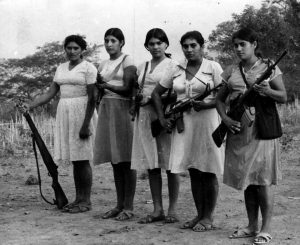
November marks 25 years since the killings, which have become emblematic of the civil war that ravaged El Salvador in the 1980s. An estimated 75,000 Salvadorans were killed in the decade-long war between a people’s movement and a U.S.-backed military government.
Father Ellacuría and his fellow Jesuits had responded to the violence by transforming UCA into a source of information about the political, economic, and social problems plaguing El Salvador. They documented the kidnappings, torture, and mass killings committed by military “death squads” and offered UCA as a venue for open debate.
“Father Ellacuría envisioned a new kind of university, one that focused all of its resources on what he called the ‘national reality,’” said Charles Currie, S.J., former president of Wheeling College and Xavier University. “He said the university had to be committed to teaching, doing research, and engaging in social outreach.”
Justice has always been at the heart of the Jesuit ethos, Father Currie said, but the dire situation in Latin America called for something radical. In 1975, Pedro Arrupe, S.J., Superior General of the Society of Jesus, called for the Jesuits to be “men for others” and implored them to embrace a “faith that does justice.”
“Our mission to proclaim the Gospel [demands]of us a commitment to promote justice and enter into solidarity with the voiceless and the powerless,” he wrote in the fourth decree of the 32nd General Congregation.
He also issued a caution: “If we work for justice, we will end up paying a price.”
Coming to UCA’s Aid
Following the murders, Father Currie traveled to El Salvador as a representative of Georgetown University. Many American Jesuits were coming to UCA’s aid, including the late Dean Brackley, S.J., who at the time was on the Fordham faculty. They found the capital, San Salvador, still embroiled in violence.
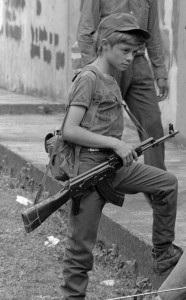
“We would go to meetings and would have to walk through gauntlets of soldiers, who would hit us with the butts of their rifles,” Father Currie said. “There was a lot of fear. You never knew what was going to happen when you opened the door—who would be out there and what they were going to do.”
At UCA, signs of the massacre were still evident.
“We went down there in early January, just over a month after the killings,” Father Currie said. “Blood was still on the ground. Everything had been left just as it was that night.”
And yet, there were also signs of what UCA had been a part of before it bore witness to the events of Nov. 16. The campus was alive with students walking to class or stretched out on the grass talking with classmates. Despite the trauma it suffered, UCA had refused to allow its spirit to be violated.
Justice and the Jesuit Campus
In the 25 years since the murders, Jesuit institutions have kept social justice at the core of their mission. A number of national initiatives evolved in direct response to El Salvador. Two of these are the Ignatian Family Teach-In for Justice, a yearly gathering to advocate for social justice issues, and the Ignatian Solidarity Network, which promotes leadership and advocacy among students and alumni.
Individual Jesuit institutions have responded on the local level withthe same ardor. Many Jesuit schools have centers dedicated to social justice, such as Fordham’s Dorothy Day Center for Service and Justice. Grounded in the philosophy of “men and women for others,” the center connects Fordham with the local community to promote service and solidarity.
“Our aim is to invite faculty and students into local partnerships that can place our hearts, research, and resources within the wider community,” said Jeannine Hill-Fletcher, Ph.D., faculty director of Fordham’s service-learning program. “We are inspired by Ignacio Ellacuría’s vision that the university is a social force and its heart must reside outside its gates.”
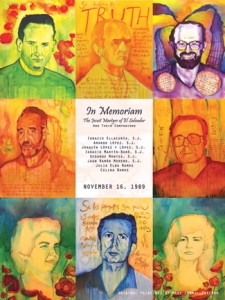
“I think it’s fair to say that no Jesuit campus today was the same after the killings in El Salvador,” Father Currie said. “Fordham has responded very generously to this vision, along with all of the Jesuit schools, by consciously committing to serving their local communities. I think that can trace back to what happened in El Salvador.”
To mark the 25th anniversary of the murders, presidents of Jesuit colleges and universities, advocates, U.S. politicians, and many others will travel to El Salvador. The delegation will meet with the nation’s leaders about urgent issues in the aftermath of the war, as well as visit sites related to the Jesuit martyrs.
The hope, Father Currie said, is to ensure for the Salvadoran people the justice that the Jesuits and their companions were denied.
“Peace without justice is not enough,” he said. “That doesn’t mean we should seek vengeance. But it is very important that we name the injustice so that we get to the root of the problem. Otherwise, peace becomes very fragile.
“The killing of the Jesuits represents a challenge to do just that,” he continued. “This 25th anniversary commemoration is the opportunity to recommit ourselves to a faith that does justice.”
The Westchester campus will celebrate a special liturgyThursday, Nov. 13.
Also on Thursday, Nov. 13 there will be a lecture at the Lincoln Center campus on the Jesuit martyrs and how they have influenced Jesuit institutions in the United States.
Twenty students will be attending the Ignatian Family Teach-In from Nov. 15 to Nov. 17, where Fordham theology professor Michael Lee will also speak.
At Rose Hill, there will be a prayer vigil on Sunday, Nov. 16 at 7:30 p.m., followed by an 8 p.m. Mass in the University Church, celebrated by Claudio Burgaleta, S.J. A meal of pupusas, a traditional Salvadoran dish, will be served after Mass.
]]>Twenty-four students graduated from History Makers, a college-preparatory program sponsored by BronxWorks and Fordham University. More than 100 family members, friends, and BronxWorks and Fordham administrators, gathered on the Rose Hill campus to celebrate the students’ accomplishments.
Now in its ninth year, History Makers is designed to reinforce students’ intention to go to college and enable them to obtain scholarships and other aid. The students, who come from eight Bronx high schools, conducted community-based research projects that identified solutions to issues that are plaguing the South Bronx.
With the help of Fordham undergraduate mentors, each student carried out independent research and then coordinated with one another to consolidate their results into four comprehensive research projects.
“These are considerable accomplishments for these students and a real taste of the kind of independent work they will be expected to initiate and finalize as part of a college curriculum,” said Jean-Pierre LaCour, program coordinator for the BronxWorks Center for Achieve Future Education, which runs History Makers.
Projects included:
Media Mirage: Research confirmed the tendencies of media to foster negative views of the life and culture of African-American and Latino youths living in the South Bronx. Findings suggest the need for significant efforts to counteract negative stereotypes suggested by the media. (Students mentored by Fordham junior Ciera Ambrose)
The Path to College: South Bronx youth who are hoping to go to college face steeper obstacles than their peers in upscale communities. This study found that, in comparison to predominantly white neighborhoods, South Bronx schools had fewer extracurricular programs and academic resources; unfair gaps in high school to college opportunities; and inadequate staffing to counsel students about preparing for college. (Students mentored by Fordham junior Courtney Williams)
School to Prison Pipeline in the Bronx: Research indicates that, when it comes to discipline and race and class biases, the Bronx school system is strikingly similar to a prison system. Inner city students and students of color experienced hostility in a number of public and charter schools, particularly in the Bronx. Research findings were corroborated by the student researchers’ personal experiences. (Students mentored by Fordham junior Anderson Bridgemohan)
Giving Hope to the Hopeless Borough: The Bronx contains a diverse, immigrant-driven population that is composed of people from various backgrounds and ethnicities. These groups have made distinctive cultural contributions that help problems the South Bronx faces. (Students mentored by Fordham sophomore Jalen Glenn)
In addition to the student mentors, Fordham participants included Kathryn Crawford, associate coordinator of service learning at the Dorothy Day Center for Service and Justice, and Fordham junior Scarly Rodriguez.
Contact: Joanna Mercuri
(212) 636-7175
[email protected]
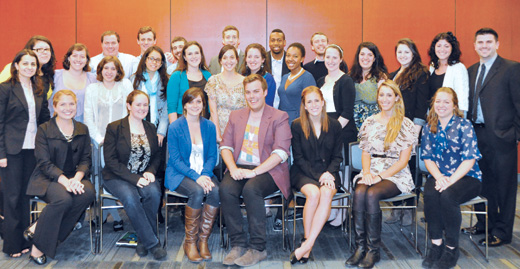 The Dorothy Day Center for Service and Justice recognized 45 seniors at a ceremony held in Campbell Commons on April 26, lauding the students’ two or more years of service. Joseph M. McShane, S.J., president of Fordham, welcomed the seniors and Monsignor Joseph Quinn, vice president of mission and ministry, presented the awards, including six special awards to seniors who gave four years of service. During the ceremony, members of the Dorothy Day Center also presented Maria Fernandez, senior coordinator of the NYC Urban Youth Collaborative, with the Community Partner Award for 2012.
The Dorothy Day Center for Service and Justice recognized 45 seniors at a ceremony held in Campbell Commons on April 26, lauding the students’ two or more years of service. Joseph M. McShane, S.J., president of Fordham, welcomed the seniors and Monsignor Joseph Quinn, vice president of mission and ministry, presented the awards, including six special awards to seniors who gave four years of service. During the ceremony, members of the Dorothy Day Center also presented Maria Fernandez, senior coordinator of the NYC Urban Youth Collaborative, with the Community Partner Award for 2012.
Sitting, from left:
Eva DeCesaro, Catharine Kane, Elizabeth Gatti, Kyle Alexander, Grace Loughney, Chrissy Kozera, Kara Finnegan
Second row, from left:
Sandra Lobo Jost (director of the Dorothy Day Center), Betamia Coronel (associate coordinator of community service at Rose Hill), Keyne Rice, Rebecca Downs, Vanessa Campo, Megan Smith, Cassandra Len, Victoria Spicer, Rachel Jones, Kara Oliveri, Gina Ciliberto, Sarah Elizabeth Lahoud, Megan Cook, Justin Freitas (associate coordinator of service learning at Rose Hill)
Back row, from left:
Christopher Kennedy, Matt Cuff, Hussein Safa, Brian Gibbons, Reynold Graham, James Wayne
Not pictured:
Alyssa Barnard, Elizabeth Certa, John Critelli, Nick Dellgatti, Asmaou Diallo, Mary Donahue, Tara Gleason, Isabel Gomez, Mark Herreros, Elizabeth Kralovec, Alycia Kravitz, Holly Lemanowicz, Leah Meredith, Stephen Moccia, Laura Notess, Elissa Rivera, William Yates, and Samantha Zimmer
Six seniors received special awards for giving four years of service.
Sitting, from left:
Rachel Jones, Hussein Safa, Grace Loughney, Megan Cook
Standing, from left:
Sandra Lobo Jost (director of the Dorothy Day Center), Betamia Coronel (associate coordinator of community service at Rose Hill), Justin Freitas (associate coordinator of service learning at Rose Hill)
Not pictured:
John Critelli and Asmaou Diallo
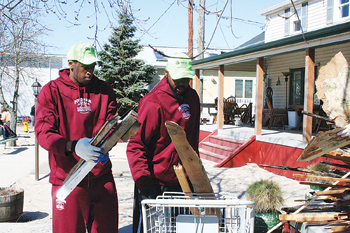
Photos by by Joe DiBari
While many students were heading to Edwards Parade to enjoy one of first warm days of spring, some 90 Fordham University student-athletes instead headed to the Rockaways on April 6, to help those affected by Hurricane Sandy as part of the University’s Sandy Solidarity Project.
The Fordham student-athletes joined a group from Habitat for Humanity Westchester, led by Executive Director Jim Killoran, in cleaning up areas hard hit by Sandy back in October. They assisted with clearing debris from houses damaged by the storm, demolishing decks that were ruined and deemed unsafe, hauling drywall to houses being renovated, and helping one homeowner to clear debris.
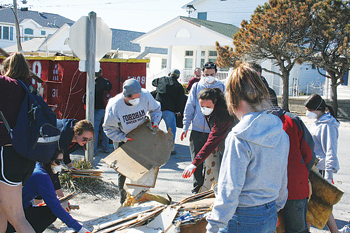
Members of the Fordham women’s swimming program provided some engineering assistance, helping level the front deck of a house that was raised by floodwaters. The women lent their muscle to dig out the temporary supports in order to let the deck level out to its original position—much to the delight of the deck’s builder.
Conor O’Kane, associate director of Campus Ministry, encouraged the student-athletes to interact with the residents and share their stories. O’Kane stressed the importance of understanding the devastation suffered by the people of Breezy Point and Far Rockaway, especially now as the storm has faded from the headlines.
“When you go back to campus, bring the lessons you learned here today with you,” said O’Kane. “Share the stories you have been told by the residents with your classmates and reflect on what it meant to the people whose lives you touched today that you were here.”
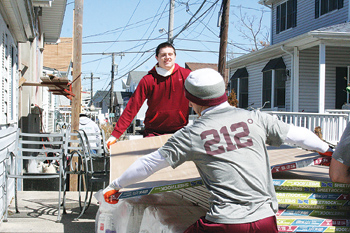
This was the second student-athlete effort toward helping Sandy victims. In January at the Fordham Breakfast for Champions, the Fordham Student-Athlete Advisory Council (SAAC) presented a financial gift to St. Francis de Sales School in Rockaway Beach, a school and parish that was severely damaged by Hurricane Sandy.
The Sandy Solidarity Program was established by the office of University Mission and Ministry and the Dorothy Day Center for Service and Justice established and includes Fordham students traveling to the Rockaways to assist the Habitat for Humanity Westchester Project in rebuilding the Breezy Point and the Rockaways.
For more photos and video of the Fordham Athletics Sandy Saturday, visit the Fordham Athletic website at www.fordhamsports.com.
by Joe Dibari
]]>
Photo by Bruce Gilbert
Though Fordham campuses were largely spared, Hurricane Sandy still upended the lives of many in the University community. Faculty, administrators and students launched a variety of relief efforts to assist those in need.
Administrative offices across the University—from the deans’ offices to Campus Ministry and the Dorothy Day Center for Service and Justice—determined how to best help students, staff and faculty affected by Sandy.
“We’re trying to respond compassionately to the needs of those members of the Fordham family who have been so deeply impacted by this storm,” said Msgr. Joseph G. Quinn, vice president for University Mission and Ministry, whose office is leading a multifaceted response to post- hurricane recovery efforts.
Regarding its students, Fordham was immediately proactive, said Michele Burris, associate vice president for student affairs.
“We did a search to see who lived in the areas that were really affected, and we reached out to those students to just ask, ‘Hey, are you doing alright? Let us know what you need,’” she said. Students were offered health services, counseling services, or whatever they needed to cope with their situations.
According to the deans’ offices, 71 students attending the Lincoln Center and Rose Hill campuses lost power, water, or heat following the storm. The Office of Residential Life housed any student that needed shelter in campus dormitories. For many students, power—and with it, normal life—was restored within two weeks of the hurricane’s landfall.
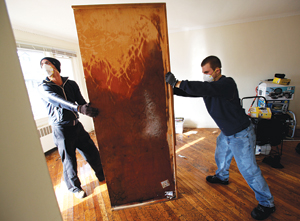
Photo by Bruce Gilbert
Students who lost their homes during the storm have been given housing on campus for the rest of the semester, paid for by an emergency fund.
Matthew White, GSB ’09, has been staying in McMahon Hall ever since the hurricane flooded his home in Rockaway Park.
“They got in touch with me the week of the storm, which was pretty impressive, because I was shoveling sand and making sure my family was okay,” said White, a student in the Graduate School of Business Administration. “I’m more than proud to say that Fordham helped me out in a time of huge need.”
In the five weeks following Sandy, more than $16,000 has been collected at Sunday Masses, interfaith prayer services, and various student activities toward a relief fund set up by the Office of the President. Non-monetary donations have also poured in.
Campus Ministry and the Dorothy Day Center have begun volunteer trips to hard-hit areas. On Nov. 17, a group of 22 students and five staff traveled to Breezy Point to aid Habitat for Humanity in the ongoing relief efforts.
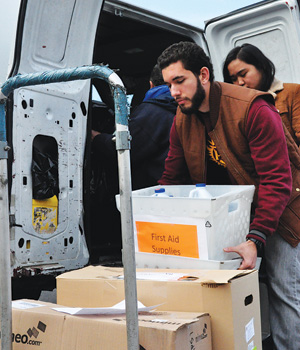
Photo by Joanna Klimaski
“We did everything from demolition to moving debris to cleaning a public space so that the people could host a fundraiser,” said Conor O’Kane, associate director of Campus Ministry at Rose Hill.
Campus Ministry continues to fill bins with items that are still needed by those affected, said Msgr. Quinn. Students transport the items to local distribution sites, such as the Kingsbridge Armory in the Bronx.
The day after Sandy hit the metropolitan area, FCLC sophomore Chris Hennessey and FCLC junior Jaime Rodriguez spearheaded a spontaneous effort at the McMahon dorms on the Lincoln Center campus, which they dubbed Occupy 109. The students organized a canned food drive in the dorm’s community room and launched the Facebook page, FCLC Hurricane Sandy Response. With the support of Maureen O’Connell, Ph.D, associate professor of theology, the effort grew in size with each passing day.
“We had a moral obligation to be there,” said Hennessey.
On Friday morning, Nov. 2, an additional 20 volunteers joined the effort to carry armfuls of supplies onto MTA busses heading into the powerless sections of lower Manhattan. By Saturday morning the number of volunteers had swelled to 60, said Rodriguez.
By that time McMahon Room 109 had become something of a command center after the local public school could no longer accept donations. Hennessey put a sign up at the school directing donations to the dorm, making McMahon the de facto distribution center for the Upper West Side. Neighbors signed on to help, with one family from the Time Warner building lending their car. Volunteers arrived from Maryland to Massachusetts, said Hennessey.
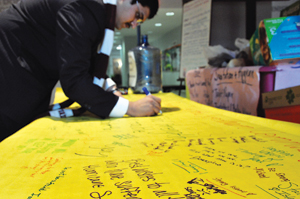
Photo by Joanna Klimaski
After the lights went back on downtown, the focus shifted to the outer boroughs. Using the Occupy Sandy website, the crew developed an online reputation for their specificity. In one case, a Brooklyn family requested a stroller and the group managed to get it to them later that day. A request for Pediasure, the children’s nutrition drink, was met after students secured a large donation of several cases from Duane Reade.
Social media drove many of the responses among the Fordham community. Mark Naison, Ph.D, professor of African and African American studies, put out a call for help on his Facebook page to assist Kendra Newkirk, FCRH ‘00, one of his former students. Newkirk had just moved into a new home in the Rockaways with her two small children. On Nov. 18, A group of Fordham alumni and Facebook friends joined Naison to help remove everything from Newkirk’s house so that FEMA could inventory what was lost.
“Kendra had her housewarming party on Sunday and the place was destroyed on Monday,” said Naison, who said seeing Sandy’s mass destruction was quite a depressing experience. “There were six of us and it took us four hours to carry every single possession that Kendra had out into the front yard. Clearly, the home was decorated with great love.”
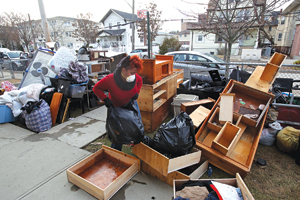
Photo by Bruce Gilbert
Newkirk, who is now staying with her mother in the Bedford Stuyvesant section of Brooklyn, is an assistant director of a daycare in the Rockaways that also sustained damage.
With the community displaced, there is little chance the daycare will reopen anytime soon, she said.
“My heart is so burdened,” said Newkirk. “I have a family that I can stay with, but there are lots of people out there who don’t have that.”
Newkirk said that the cleanup would not have been possible without the help.
“It was just phenomenal. These are people I’ve never met,” she said. “I definitely didn’t anticipate the mental and spiritual support that I got. I didn’t expect that at all.”
O’Kane said that students, faculty, and staff who would like to volunteer are encouraged to visit Campus Ministry’s website, which will be updated daily with volunteer opportunities.
“This will be a very long process and I think the heart of Fordham’s responsibility to our neighbors and our brothers and sisters is to cultivate a critical awareness of that, especially when it begins to fade from the news cycle,” he said.
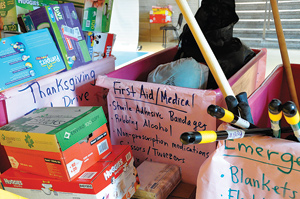
Photo by Joanna Klimaski
Joanna Klimaski and Tom Stoelker contributed to this report. To donate to the Disaster Relief Fund, visit http://www.fordham.edu/info/20094/campus_ministry
]]>Now we’ve got a chance to show the rest of New York City just how charitable they are.
According to Sandra Lobo Jost, director of Fordham’s Dorothy Day Center for Service and Justice, the University has joined the Mayor’s College Challenge Initiative, which is a competition between New York City universities and colleges to see who can rack up the most service hours.
“Anyone who is volunteering for a non-profit 501(c)(3) within New York City can log into the mayor’s website, create and account and register their hours, which is then recorded on the website instantly,” she said.
“I believe Fordham could easily rise to the top of the list (we are number 9 right now), if we could only get the word out to the Fordham family and get them to log on their hours!”
The challenge runs through March 30. For more information, visit http://www.nycservice.org/college_challenge.php or contact Sandra Lobo Jost at 718-817-4510
—Patrick Verel
“The Catholic Worker at 75: A Celebration and a Retrospective” was held on Nov. 8 in Tognino Hall at Duane Library on the Rose Hill campus. Organized by the Francis and Ann Curran Center for American Catholic Studies, it was timed around the 75th anniversary of the newspaper The Catholic Worker, which Day co-founded.

On the afternoon’s first panel, Amanda Daloisio and Tanya Theriault spoke of their experiences working at Maryhouse and St. Joseph’s House, respectively. The facilities are two of nearly 200 worldwide that provide housing for the downtrodden.
Kate Hennessy, a writer and musician who works with the disabled, spoke about how having Day as a grandmother presented her with huge shoes to fill. Patrick Jordan, the managing editor of Commonwealmagazine and a former occupant of St. Joseph’s House, said that to know Day was to ask yourself, “What hit me?”
On the second panel, Phillip M. Runkel,an archivist for the Dorothy Day Catholic Worker Collection at Marquette University, talked about how the Milwaukee college came to possess Day’s papers.
Paul Elie, who profiled Day in The Life You Save May Be Your Own: An American Pilgrimage (Farrar, Straus and Giroux, 2004), praised Day as an extraordinary writer. In fact, her autobiography, The Long Loneliness (Harper One, 1996), was powerful enough to drive him to volunteer with a Hospitality House.
“There’s a whole movement dedicated to carrying out a model of her life that is embodied in large part, or expounded by, her writings,” he said. “How many writers can we say that about?”
Mel Piehl, Ph.D., dean and professor of humanities and history at Christ College, Valparaiso University, gave a Lutheran’s perspective on Day and her legacy.
He got laughs from the audience by noting that there was some initial suspicion of Day in Protestant circles because they suspected she was a pawn of the Pope. In some ways, he said, she had a lot in common with Martin Luther.
“She was someone who loved the church so passionately that she wanted it to be more fully what it was, to ground itself more profoundly in Christ than its human and institutional and social manifestations might reveal,” he said.
Robert Ellsberg, the editor in chief of The Catholic Worker and the editor of The Duty of Delight: The Diaries of Dorothy Day (Marquette University Press, 2008), closed out the panel by saying that Day, who convinced him to convert to Catholicism, should be considered for sainthood. Her devotion to faith, which comes through in her diaries, shows that hers was not a life consumed with moments of deep ecstasy, but an ordinary life given up to God.
“When we think of holy lives, we kind of boil it down to these dramatic moments in life,” he said. “There are a lot of dramatic elements in Dorothy Day’s life. But you realize that for any life, the substance is made up of ordinary kinds of things.”
]]>
Photo by Chris Taggart
New York City’s poorest renters are being priced out of other boroughs and are moving to the West Bronx, one of the last bastions of affordable housing in the city, according to Gregory Lobo Jost, deputy director of the University Neighborhood Housing Program (UNHP), speaking at the 2007 Affordable Housing Forum, held March 27 on the Rose Hill campus.
Jost said the average rent on a one-bedroom rent-stabilized apartment in the Bronx remains the lowest among the five boroughs. But the UNHP’s report, “Shrinking Affordability,” warned of the need to preserve such rents before they completely disappear in a city where the average vacancy rate has been steadily dropping.
“The question is: Who will be able to live in the Bronx in the next ten years?” Jost said. “Preservation of affordability needs to be the cornerstone of public policy and housing dollars.”
Jost cited a trend that shows an increase in the percentage of household income going toward rent. Among the areas of Highbridge/South Concourse, Morrisania/Belmont and Kingsbridge Heights/ Mosholu, renters paid their landlords between 40 and 46 percent of their household income. At the same time, the median annual income of residents moving to the Bronx has dropped, as median annual incomes of new residents in all the other boroughs have risen.
“While the rents in the West Bronx corridor are among the lowest in the city, the people arriving are struggling to afford what is available,” he said.
The UNHP is a Community Development Financial Institution begun by Fordham University’s Board of Trustees in 1983 to help create, preserve and finance affordable housing in the Northwest Bronx. The UNHP report presented demographic trends in household incomes, vacancy rates and prices per unit for Bronx multifamily housing. Panelists from the private, public and nonprofit sectors commented on the report following its release.
Frank Anelante, CEO of Lemle and Wolff Real Estate and owner of 8000 units of housing, said that, as a landlord, the city’s “onerous” rehabilitation requirements leave building owners with very little discretionary income on “affordable housing” projects. “If it costs me $479 per unit to operate, and I can only get $600 rent, there is a squeeze on guys like me,” he said.
The UNHP called for more public, private and nonprofit assistance tools and increased oversight of city credits to landlords. Director Jim Buckley (FCRH ’76), said that, as a Fordham undergrad, he recalled “the smell of smoke” permeating the West Bronx when the neighborhood was plagued with abandoned buildings and arson fires. “A remarkable recovery happened in this borough,” Buckley said. “And many of the people in this room deserve credit for its success. But we don’t want to rest on our laurels. We want to keep reasonable, affordable rents, and keep the neighborhood safe for the folks who live here.”
The UNHP maintains an office in the Bronx and can be reached at (718) 933-3101.
– Janet Sassi
]]>